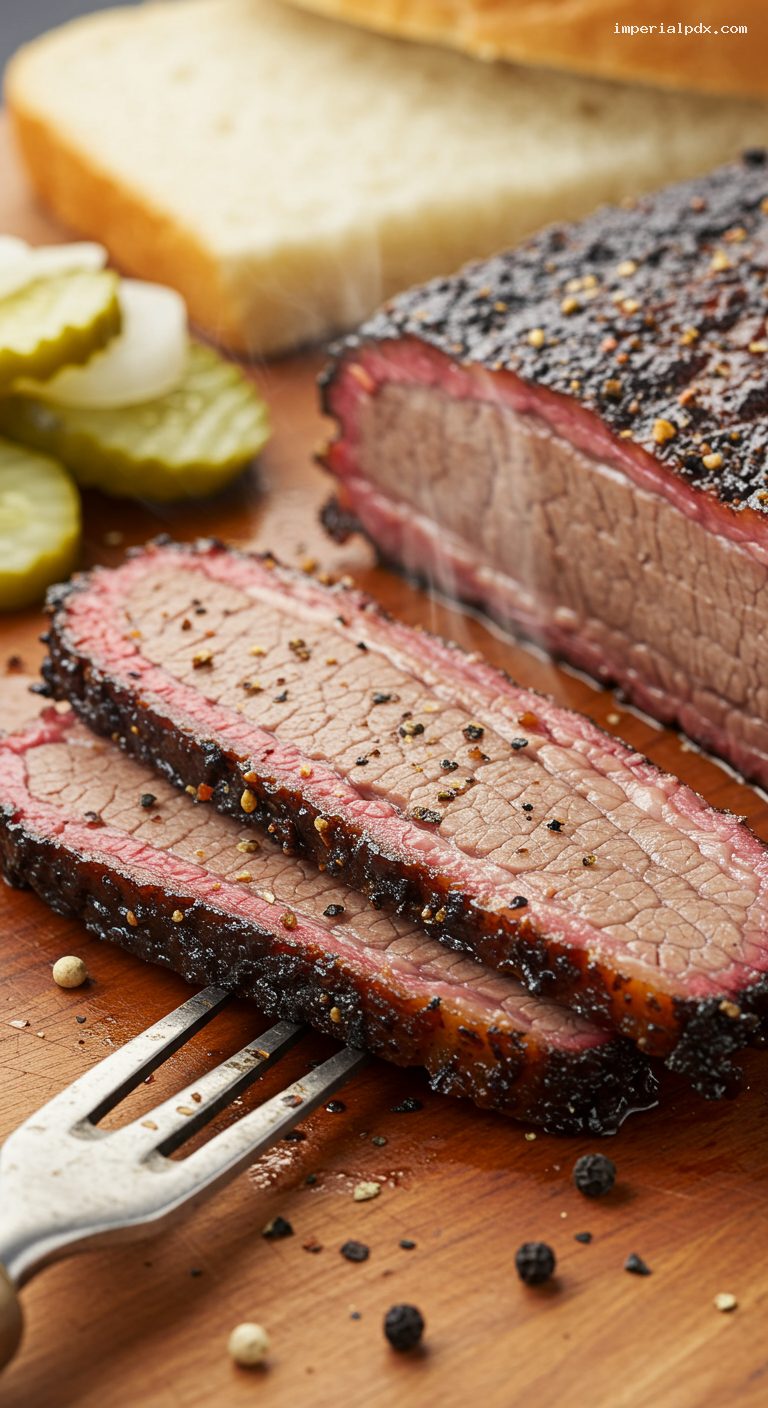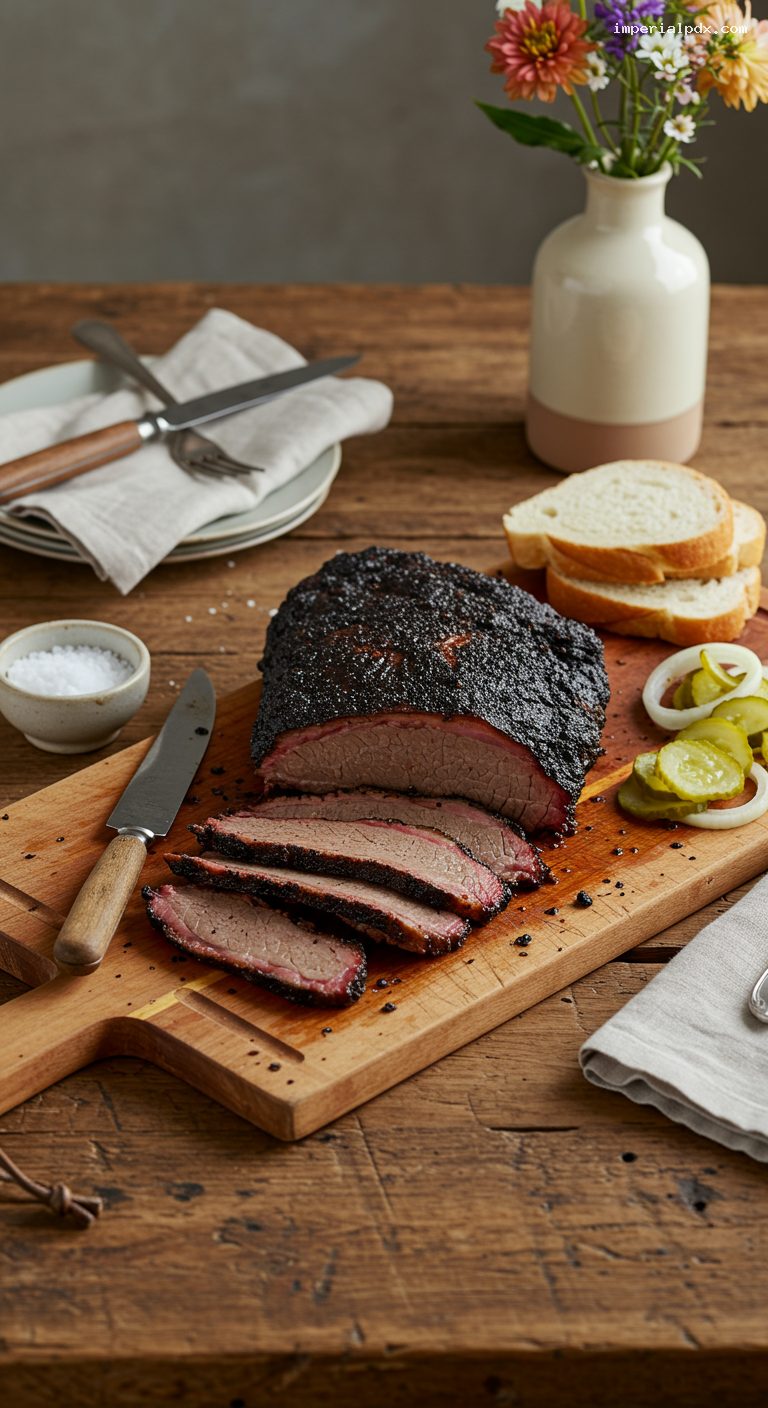Quick Recipe Version (TL;DR)
Quick Ingredients
- 1 whole packer brisket, 12–14 lb (USDA Choice or Prime)
- 1/4 cup (34 g) Diamond Crystal kosher salt (or 2 1/2 tbsp Morton kosher salt)
- 1/3 cup (36 g) 16-mesh coarse black pepper
- 2 quarts hot water for the water pan, plus more to refill
- 3–4 fist-sized chunks post oak or hickory (for smokers) or appropriate pellets
- 1 small white onion, thinly sliced; 2 cups dill pickle chips
- 1 loaf soft white sandwich bread or Texas toast
Do This
- 1. Trim brisket to a 1/4-inch fat cap, remove hard pockets of fat, and lightly square edges; mark the grain on the flat with a small corner cut.
- 2. Season all sides evenly with salt and pepper. Dry-brine uncovered in the fridge 8–24 hours, or at least 1 hour if rushed.
- 3. Preheat smoker to 250°F (121°C) with a water pan filled with 2 quarts hot water. For oven, preheat to 275°F (135°C) and place a water pan on the rack below.
- 4. Cook brisket fat-cap down if heat is from below (smoker), fat-cap up if heat is from above (oven). Maintain steady temp until 165–175°F internal and the bark is set.
- 5. Wrap tightly in unwaxed butcher paper (or heavy-duty foil), seam down. Optional: add 1–2 tbsp beef tallow to the top before wrapping.
- 6. Continue cooking to 200–205°F internal; confirm it is probe-tender. Rest wrapped 1–3 hours in a warm cooler or 150–165°F oven.
- 7. Separate point and flat. Slice across the grain into 1/4-inch slices; serve with pickles, white onion, and soft white bread.
Why You’ll Love This Recipe
- Classic backyard brisket with a simple salt-and-pepper rub that lets the beef shine.
- Detailed guidance for both smoker and oven—no specialty pit required.
- Water-pan method helps you get tender, jiggly slices and a beautiful peppery bark.
- Perfect for feeding a crowd with straightforward slicing and no-fuss sides.
Grocery List
- Produce: 1–2 white onions
- Dairy: Optional: 2 tbsp unsalted butter or beef tallow
- Pantry: Whole packer brisket (12–14 lb), kosher salt, coarse black pepper (16-mesh if possible), dill pickle chips, soft white sandwich bread or Texas toast, unwaxed butcher paper or heavy-duty foil, wood chunks or pellets, water
Full Ingredients
Brisket
- 1 whole packer brisket, 12–14 lb (USDA Choice or Prime)
Simple Salt-and-Pepper Rub
- Diamond Crystal kosher salt: 1/4 cup (34 g) for a 12–14 lb brisket (or use 0.5% salt by weight of meat)
- Morton kosher salt (if substituting): 2 1/2 tbsp (about 36 g)
- 16-mesh coarse black pepper: 1/3 cup (36 g)
For Smoking or Oven Setup
- 2 quarts hot water for the water pan, plus 1–2 quarts more to refill as needed
- Smoker wood: 3–4 fist-sized chunks post oak or hickory (or pellets to match)
- Unwaxed butcher paper (two 24 x 30-inch sheets) or extra-wide heavy-duty foil
- Optional: 1–2 tbsp beef tallow or unsalted butter
To Serve
- 2 cups dill pickle chips
- 1–2 small white onions, very thinly sliced
- 1 loaf soft white sandwich bread or Texas toast (16–20 slices)

Step-by-Step Instructions
Step 1: Trim the brisket and mark the grain
Place the brisket cold on a large board, fat-side up. With a sharp knife, trim the fat cap to an even 1/4 inch. Remove hard, waxy pockets of fat (especially near the point) and any thin, ragged edges that will dry out. Flip the brisket and clean up silver skin on the meat side as needed. Before seasoning, make a small 1/2-inch cut on a corner of the flat to mark the grain direction—this makes slicing correctly much easier later.
Step 2: Season simply and dry-brine
Stir salt and pepper together. Sprinkle generously and evenly on all sides of the brisket, including edges; pat to adhere without rubbing off the crust. Place on a wire rack set over a sheet pan. Refrigerate uncovered 8–24 hours for a dry brine that improves seasoning and bark formation. Short on time? Rest at room temperature for 60 minutes while you prepare your cooker.
Step 3: Preheat with a water pan
For a smoker: Preheat to 250°F (121°C). Set a full water pan (2 quarts hot water) near the heat source to keep humidity steady. Add post oak or hickory, aiming for thin, clean blue smoke.
For an oven: Set a rack in the lower third with a roasting pan filled with 2 quarts hot water. Preheat to 275°F (135°C). Place a wire rack above the pan to keep the brisket out of the water.
Step 4: Start the cook and build bark
Place the brisket with fat-cap down if your heat comes from below (typical offset, ceramic, or kettle smokers). For ovens or top-down heat, place fat-cap up. Insert a probe thermometer into the thickest part of the flat. Cook undisturbed, maintaining steady temperature and refilling the water pan as needed. After about 4–6 hours, the bark should darken and feel dry and set when tapped. Internal temperature will typically be in the 160–170°F range (the stall).
Step 5: Wrap when bark is set (165–175°F)
When the bark is firm and the internal temperature is 165–175°F, wrap tightly in two layers of unwaxed butcher paper (preferred for bark) or heavy-duty foil (tighter, quicker cook). If you like, smear 1–2 tablespoons beef tallow on the top of the brisket before wrapping. Return the brisket to the cooker, seam-side down.
Step 6: Finish to probe-tender at 200–205°F
Continue cooking until the brisket reaches 200–205°F and a probe slides into the flat with little resistance, like warm butter. This usually takes a total of 10–14 hours at 250°F in a smoker, or 8–10 hours at 275°F in an oven, depending on brisket size and thickness. If you need to speed up slightly after wrapping, you can safely increase smoker or oven temperature to 265–275°F.
Step 7: Rest until jiggly
Vent the wrapped brisket for 5 minutes on the counter, then re-wrap snugly and rest 1–3 hours. Ideal holding temp is 150–165°F (use a warm oven or an insulated cooler lined with a towel). Resting lets juices redistribute and softens connective tissue further. The finished brisket should feel supple and jiggly when lifted.
Step 8: Slice and serve
Unwrap, reserving any juices. Separate the point from the flat by following the natural seam of fat. Slice the flat across the grain into 1/4-inch slices (pencil-thick). Rotate the point 90 degrees and slice across its grain into slightly thicker slices. Arrange on a warm platter and spoon over reserved juices if desired. Serve with dill pickle chips, thin white onion slices, and soft white bread.
Pro Tips
- Use 16-mesh pepper for classic Texas-style bark; it adheres well and creates a balanced crust.
- Salt by weight for consistency: aim for 0.5% of raw brisket weight (e.g., ~30 g salt for a 13 lb brisket).
- For smokers with lower grates running hotter on one side, rotate the brisket 180° halfway through the unwrapped phase.
- Don’t chase smoke—clean, thin blue smoke is ideal. Thick white smoke turns bark bitter.
- Slice only what you’ll serve immediately; keep the rest wrapped to preserve moisture.
Variations
- Garlic-pepper: Add 1 tbsp granulated garlic to the rub for a subtle savory note (still lets beef shine).
- Hot-and-fast finish: After wrapping, increase to 275°F to shorten the cook by 60–90 minutes without sacrificing tenderness.
- Oven method with faux bark insurance: Start at 300°F for 45 minutes to set color, then reduce to 275°F; wrap when bark is set.
Storage & Make-Ahead
Cool leftovers to room temperature (no more than 2 hours), then refrigerate in airtight containers up to 4 days or freeze up to 3 months. Store larger pieces unsliced for best moisture. Reheat wrapped in foil with a splash of beef broth at 300°F until 165°F internal, or steam slices gently for 5–8 minutes. For premium results, vacuum-seal slices with a little jus and reheat in a 165°F water bath for 45–60 minutes.
Nutrition (per serving)
Approximate for 1 serving (about 6 oz cooked brisket, 2 slices soft white bread, pickles/onion): 750 calories; 39 g protein; 44 g fat; 28 g carbohydrates; 980 mg sodium.



